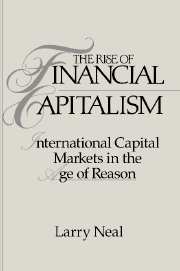Book contents
- Frontmatter
- Contents
- Acknowledgments
- 1 Historical background for the rise of financial capitalism: commercial revolution, rise of nation-states, and capital markets
- 2 The development of an information network and the international capital market of London and Amsterdam
- 3 The early capital markets of London and Amsterdam
- 4 The Banque Royale and the South Sea Company: how the bubbles began
- 5 The Bank of England and the South Sea Company: how the bubbles ended
- 6 The English and Dutch East Indies companies: how the East was won
- 7 The integration of the English and Dutch capital markets in peace and war
- 8 The English and Dutch capital markets in panics
- 9 The capital markets during revolutions, war, and peace
- 10 A tale of two revolutions: international capital flows, 1792–1815
- 11 The Amsterdam and London stock markets, 1800–25
- Appendix End-of-month share prices
- Bibliography
- Index
11 - The Amsterdam and London stock markets, 1800–25
Published online by Cambridge University Press: 25 March 2010
- Frontmatter
- Contents
- Acknowledgments
- 1 Historical background for the rise of financial capitalism: commercial revolution, rise of nation-states, and capital markets
- 2 The development of an information network and the international capital market of London and Amsterdam
- 3 The early capital markets of London and Amsterdam
- 4 The Banque Royale and the South Sea Company: how the bubbles began
- 5 The Bank of England and the South Sea Company: how the bubbles ended
- 6 The English and Dutch East Indies companies: how the East was won
- 7 The integration of the English and Dutch capital markets in peace and war
- 8 The English and Dutch capital markets in panics
- 9 The capital markets during revolutions, war, and peace
- 10 A tale of two revolutions: international capital flows, 1792–1815
- 11 The Amsterdam and London stock markets, 1800–25
- Appendix End-of-month share prices
- Bibliography
- Index
Summary
London definitively replaced Amsterdam as the financial center of Europe during the period of war and revolution discussed in the preceding two chapters. Acworth described it thusly:
In 1792, Great Britain held a subordinate position in the financial system of Europe, the London money-market had yet to come into its own, and the movement of capital was still into and not out of England. In 1815, though the fact was scarcely appreciated at the time, the situation had radically changed. Amsterdam had fallen; and London had not only taken its place as the predominant financial market of Europe, but was able to play the part in a way that dwarfed the earlier efforts of the Dutch city.
Not surprisingly, the stock exchanges in both cities underwent substantial reorganizations in that period. Those in London reflected not only the growth in the volume of the traditional assets traded, the government funds, but also the growth in the number of traders and in a variety of new assets. New buildings were constructed to house the exchange's activities. Amsterdam, by contrast, found its numbers reduced, its financial assets reduced in number and quality, and its activities devoted increasingly to real estate transactions. In the course of that historic transformation of the two markets, it is not surprising that the tight links that had been established and maintained for a century between the two markets were substantially loosened. And it is not surprising that a rampant and expanding London market should forge new links that would secure its dominance in world finance through the next century.
- Type
- Chapter
- Information
- The Rise of Financial CapitalismInternational Capital Markets in the Age of Reason, pp. 223 - 230Publisher: Cambridge University PressPrint publication year: 1991



